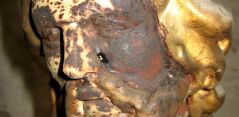MLZ is a cooperation between:
 > Technische Universität München
> Technische Universität München > Helmholtz-Zentrum Hereon
> Helmholtz-Zentrum Hereon
 > Forschungszentrum Jülich
> Forschungszentrum Jülich
MLZ is a member of:
 > LENS
> LENS > ERF-AISBL
> ERF-AISBL
MLZ on social media:

MLZ (eng)
Lichtenbergstr.1
85748 Garching
18.11.2021
Revolution in imaging with neutrons
FRM II research group develops new processing method for image data

Instrument scientist Dr. Adrian Losko at the NECTAR neutron radiography facility. © Bernhard Ludewig / FRM II, TUM
An international research team at the Research Neutron Source Heinz Maier-Leibnitz (FRM II) of the Technical University of Munich (TUM) has developed a new imaging technology. In the future, this technology could not only improve the resolution of neutron measurements by many times, but could also reduce the radiation dose for medical x-ray imaging.
Modern cameras still rely on the same principle they used 200 years ago: Instead of a piece of film, today an image sensor is exposed for a certain period of time in order to record an image. During this process, any wanted but also unwanted contibutions to the image are recorded. Particularly for long exposure times, this can produce considerably high levels of noise in the images.
Together with colleagues from Switzerland, France, the Netherlands and the USA, Dr. Adrian Losko and his TUM colleagues at the Heinz Maier-Leibnitz Zentrum (MLZ) have now developed a new imaging method which measures individual photons on a time-resolved and spatially-resolved basis. This makes it possible to separate for example neutrons from noise, greatly reducing the unwanted contributions in radiographs.
“Our new detector lets us capture every individual photon and thus overcome many of the physical limitations of traditional cameras,” says Dr. Adrian Losko, instrument scientist at the NECTAR neutron radiography facility of the Heinz Maier-Leibnitz Zentrum at the Technical University of Munich.

Camera with image amplifier and zoom lens. The pink cable sends up to 80 million activated pixels per second to a high-performance PC for data analysis. © Bernhard Ludewig / FRM II, TUM
Measuring individual photons
Neutron researchers typically use scintillators for imaging measurements to detect neutrons for example in the examination of fossilized dinosaur specimens. When the scintillator material absorbs a neutron, photons are generated which can then be measured using optical cameras.
Until now, all of these cameras have collected light during the entire exposure time, whereby the image sharpness is strongly dependening on the thickness of the scintillator. The research team’s new concept on the other hand detects each individual photon generated by a neutron, allowing to reconstruct a more precise origin of each individual neutron interaction.
“The prerequisite was a new chip technology as well as hardware and software that support computing speeds which enable real-time analysis. This lets us compose an image recording neutron by neutron,” explains Losko. Here, neutron research offers an ideal test and application field.
Instead of longer exposure times: Measuring the relevant events only
Since the absorption of a neutron in the detector generates many photons, the new system makes use of the coincidence of several photons to determine individual neutrons. “This takes us away from the traditional model of exposure time and we record only those events which are relevant to form the final image.”
Compared to all technologies previously available on the market, the new concept is a dramatic improvement since it already at the current stage enables three times better spatial resolution and reduces the amount of noise by more than a factor of seven. “This greatly reduces the limitations resulting from the thickness of the scintillators, which means higher efficiency for high-resolution measurements,” says Losko. And the afterglow of the scintillators, which creates what is referred to as “ghost images,” is eliminated as well.
“Many of the instruments at the research neutron source reactor can benefit from our new concept,” observes Losko, citing as an example the instrument FaNGaS (Fast Neutron-induced Gamma-ray Spectrometry): “Since we know exactly when a neutron arrives, the time-span during which we measure the gamma particle can be reduced to a millionth of a second.” This would reduce the background noise by a factor of one million, he adds.
Lower radioactive exposure and more details in hard x-rays
The new detector can also be applied in medical fields. When making an x-ray image of a broken bone for example. Fine structures, such as hairline fractures, would be more easily detectable; at the same time, the patient’s exposure to radiation could be reduced.
“Our method will definitely change detectors in the scientific world,” says Losko. And perhaps similar principles will also make their way into application in everyday cameras for personal use. Images made in the dark would be greatly improved, and photographers could adjust exposure time and resolution after the exposure is taken. Noise could be practically eliminated with such cameras.
Original publication
Adrian Losko, Yiyong Han, Burkhard Schillinger, Aureliano Tartaglione, Morgano, Markus M. Strobl, Jingming Long, Anton Tremsin, Michael Schulz
New Perspectives for Neutron Imaging through Advanced Event-Mode Data Acquisition
Sci Rep. 11, Article number: 21360 (2021) – DOI: 10.1038/s41598-021-00822-5
More information:
The research activities were supported by German Federal Ministry of Education and Research (BMBF) under the grant number 05K19WO2. In addition to the scientists of the Research Neutron Source Heinz Maier-Leibnitz (FRM II) at the Technical University of Munich, researchers at the Paul Scherrer Institute PSI in Villigen, Switzerland, Amsterdam Scientific Instruments B.V. and the Space Sciences Laboratory of the University of California, Berkeley were also involved in the project.
Contact:
Dr. Adrian Losko
Technische Universität München
Forschungs-Neutronenquelle
Heinz Maier-Leibnitz (FRM II)
Tel: +49 89 / 289-14756
Email: Adrian.Losko@frm2.tum.de
Related News
MLZ is a cooperation between:
 > Technische Universität München
> Technische Universität München > Helmholtz-Zentrum Hereon
> Helmholtz-Zentrum Hereon
 > Forschungszentrum Jülich
> Forschungszentrum Jülich
MLZ is a member of:
 > LENS
> LENS > ERF-AISBL
> ERF-AISBL
MLZ on social media:




